Dear Shaded Viewers,
So, arriving at last at couture shows for 2024, we note that for much of the time since the global pandemic in 2020 and the gradual return of couture, shows have on the whole, been “nice”.
This season, merely a glance at the locations gave a hint that couture was going all out for show impact. Below are the key shows that for me offered personal views of couture, fashion presentations, and demonstrated that far from playing it safe, Paris is “en pleine forme” or “fit as a fiddle”.

Schiaparelli opened the week in the huge space at the Petit Palais, in itself a national museum and with a wonderful entrance up a vast curved set of steps, perfect to pose and wave in your Schiaparelli, be it from top to toe, or simply a few accessories. We saw true couture pieces from digital recycling “embroidery”, lunar and astral influences and out of this world shapes, Daniel Roseberry wows his audience with creativity and extraordinary use of what couture ateliers are capable of realising. A visit to Place Vendome to see the pieces in the hand reveals out of this world craftsmanship and details of staggering inventiveness. It’s truly the laboratory of fashion. It’s all traceable back to the designer, who, ever since his first couture show has relished the journey. Roseberry was seated at a drawing board in layers of sweatshirting, remembering his first days in freezing cold designing. His creativity even allowed us to watch him in Washington Square Park, New York drawing and unable to get to Paris in July 2020; he is a true creative spirit.
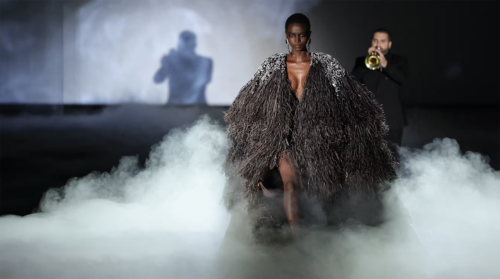
Stephane Rolland took over the vast hall of the classic Salle Pleyel with seating for two thousand. He placed the mood in the desert with projections, film, and images of birds in flight and sand dunes. The soundtrack was a skilful blend of Debussy, Massenet and Dlibes amongst others wrapping in the collection in the perfect aural atmosphere. The huge stage into runway curved upwards and at any time several models were prowling and pacing the space. Fabrics flowed and billowed, wrapped and unfolded, sparking and shimmering details were revealed and then concealed, cascades of bullion swung over transparent layers and the collection conveyed an almost legendary imagery. “The Wilder Shores of Love” by Lesley Blanche came into my mind, alongside Kismet, Scheherazade and conjured up djellabas’s, kaftans and robes with splendour. Strong women indeed, proud and tall, and when the entire cast appeared with the final outfit of layered fringed raffia, plus the live trumpeter the crowd roared. Haute couture as theatre? Certainly.

Swiftly on the heels of this we entered a very different theatre to witness Julien Fournie’s collection; Theatre Mogador opened in 1919, and often the home of musicals, we were in a truly theatrical space with gilded boxes, red plush and tiers of seating. First Vamp offered a parade of Parisienne charmers whose images hinted at past vamps and divas, but with Fournie’s eye firmly on today and his clients. From Lauren Bacall to Betty Boop, from Theda Bara to Monroe thee we’d hints of Hollywood but in the end, it was about a witty, sexy collection of looks from urban trouser suit to gala glamour. From crisp tailoring to drop dead satin and lace. At the final line up across the stage with Monsieur Fournie taking his bow, he was a fashion Ziegfeld with his girls; and the audience loved it.
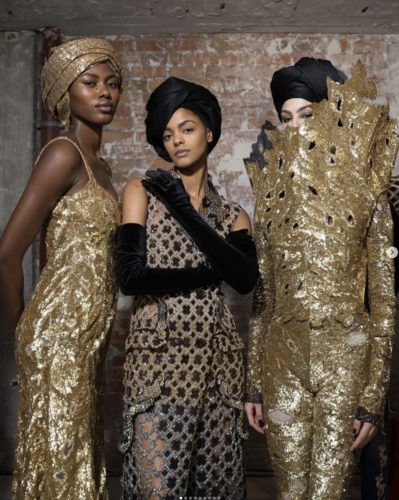
Rahul Mishra placed his performance in a vast industrial space hung with enormous glittering chandeliers. It was apparently an old telephone center, and certainly staggering up the concrete stairs we knew it was in the middle of restoration. As the first huge circular pieces appeared with a dragonfly shimmering and bees buzzing it became clear the insect life was being recreated by Mishra’s amazing ateliers and embroiderers. The collection was perfectly balanced between show pieces and more wearable, but lavish looks, plus some really pared back interpretations of couture on pants suits, short dresses or streamlined strapless. The collection showed how extreme creative statements can be used in couture alongside “real” clothes yet in total harmony and with a coherent thought of nature and its importance in our lives. Rahul Mishra is very articulate about his work, and this is because he is confident in his work, his culture and his teams’ abilities.
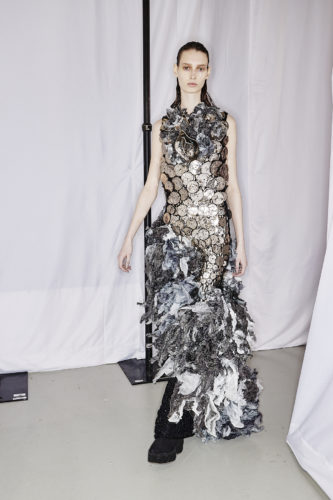

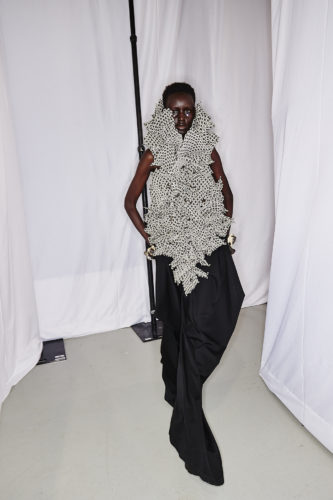
 Yuima Yuima Nakazato photos by Sonnyphotos
Yuima Yuima Nakazato photos by Sonnyphotos
Japanese designers are often amazingly avante garde but in ready to wear, Miyake, Yamamoto, Kawukabo, etc. Yuima Nakazato relished the laboratory aspect of couture in a totally original way. As we enetered Palais de Tokyo space we spied a white runway with shallow perfectly circular pool filled with deep red liquid. Out notes told us Nakazato had been working on costumes for the Mozart opera “Idomeneo” and the collection was a progression or extension from this work. Male and female models wandered slowly and almost hypnotically down the white pathway. A slight hint of military infused the clothes, but it was the way pieces had of tumbling in a semi undone way, the tinkle of the metallic adornments and embellishments, and the softly drifting quality which entranced the audience. The live music later and the performer who stepped into the pool in top to toe white added to the event. But in the final analysis it was the clothes, the collection the pieces which focussed our attention. The surrounding elements added to the operatic moment, but it never obscured beautiful pieces.

015_©LaurentStephaneMontfort_189.photography_FranckSorbier
Studios Harcourt is a famous name in France especially, with portraits across the decades always using lighting as an essential creative tool. Founded in 1934 by Cosette Harcourt vintage prints demand high prices. Franck Sorbier is a French couturier whose patrons and followers have been faithful for many decades. He creates a performance which always has a very French influence, and his reference points are French. During lockdown his films were probably the best by anyone, including major houses with huge budgets. His narratives draw the observer in and create an atmospheric bubble during the show. This season with Corsica the underlying thread, we witnessed an almost Spanish influence the signature worked fabrics with rich texture, the fitted bodices enhancing curves, the impeccable use of black lace and the graphic elements all combined to seduce the jammed crowds in the spaces across the studio.




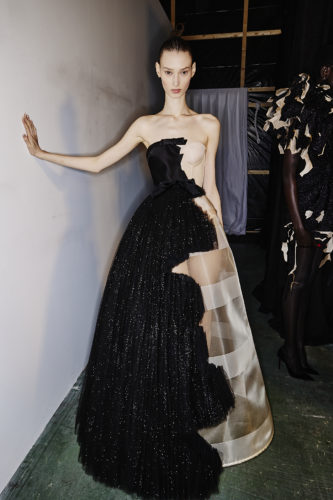
Viktor & Rolf photos by Sonnyphotos
Ever since their very first collection Viktor & Rolf have surprised us. So, entering a big white space at the Sorbonne Nouvelle anticipation ran high. The invitation featured a big pair of cutting shears as used in any fashion work room. Well, that was the clue. Each group of four models featured one perfect dress and three increasingly scissored variations one after the other. The entire collection was in Victorian mourning black, plus face powder nude. The underpinnings were often revealed and had a slightly historical feel with bandings, ruffles, boning and so on, again as though a Victorian lady had met with an accident. The slashing was perfectly realised with immaculate couture finishes, nothing tattered or haphazard about this slashing. Possibly closer to the 16th century idea of cutting to increase impact rather than a destructive technique it was another Viktor & Rolf surprise after so many years of them. Never try to second guess these two; I was convinced they’d be wearing slashed looks too, but no, they were neatly and conservatively clad.
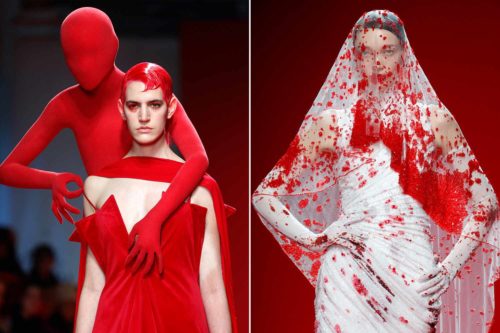
First collections often show all a designer has to offer, like a first album for a singer, it’s the second that can show if there’s real mileage, or a one hit wonder. After Robert Wun’s couture debut closing the season a year ago, what would we see? The location was Palais de Tokyo with a brilliant red catwalk and back drop, anticipation was high, and we truly wondered what might appear. Cleverly he introduced us subtly to the season by developing his extraordinary raindrops look, into the two first outfits, gradually the models stalked the runway in true examples of couture, including the extraordinary blood bride. Although much has been made of the time, hours and work on this look, it’s the impact which truly counts, this was beautiful dripping with red beading and draping and dragging along the catwalk. Wun offered a Jackson Pollock like spatter explosion, wicked extensions of silhouette and drapery that swagged around the wearer. It was like a series of roles in an unknown drama, each a character, each a work of art, and each centre stage.
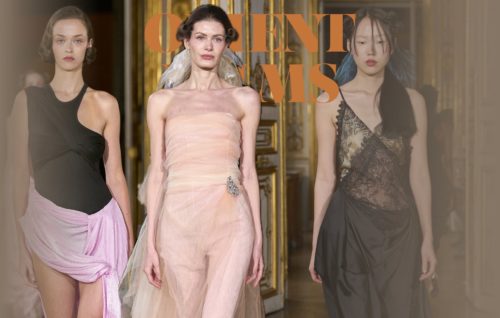
Peet Dullaert at the Hotel Soubise was a different kind of magical and theatrical. Although Dullaert was established in 2012 this was his official debut at couture. Personal responses to a show aren’t the same as professional evaluation. I loved this collection for a certain quality I often associate with Belgian creativity, an underlying sadness, not misery, but a touch of sadness. I see it in Dries Van Noten, RF Simons and others even Dirk Bikkembergs. Although Dullaert is Dutch s slight melancholy drifted through my consciousness. Like a first ball, a first love, or Chekhov, the clothes had a freshness and a real presence as they appeared. Soft colours, soft fabrics, and even soft tailoring gave the collection a very specific air. Shown in the slightly dusty splendour of the Hotel Soubise the rooms felt as if they contributed to the show with their mirrors, gilding and boiseries.

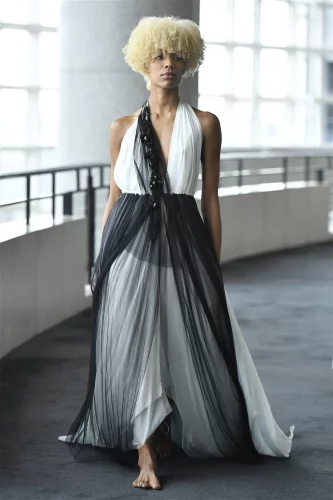
The Opera Bastille opened in 1989, it’s no longer “modern”, the long curving space Aelis designer Sofia Crociani showed her collection in was several floors up allowing a view of every Paris monument, from Bastilel, to Sacre Coeur, Eiffel Tower and Notre Dame. The music for the show was provided by cellist Julie Lederach, and the pace was slow and deliberate as if often is with Aelis, time to examine the craft as each model passes, time to view from all sides since Crociani understand the need for beauty to be from every angle. Her upcycling, recycling, dead stock and vintage mix is always so alluringly transformed into her personal view of beauty.

The American Church in Avenue George Cinq is not a new show venue but it’s gothic and religious architecture and atmosphere suited the third showing at Paris couture of Gaurav Gupta. The use of white, a soft oyster shade and deep lacquer red, plus some celestial blue fitted perfectly in the setting. The shimmer of embroidery and lavish beading flowed around the body, as did Gupta’s signature sculptural shapes. The trick is to view the pieces from every angle as the designer’s skill, alongside his workrooms is that the pieces flow and embrace the body of the wearer, there’s no back and front it’s three hundred and sixty degrees of fabric and form, it’s more about fluid and pouring fabric as liquid than it is just clothes. The hint of sari in a fold there or a drape there hints at the designers cultural influences, but just as a passing reference. Gupta is new to couture but, beauty, elegance and craftsmanship remain key as they always should with true couture.
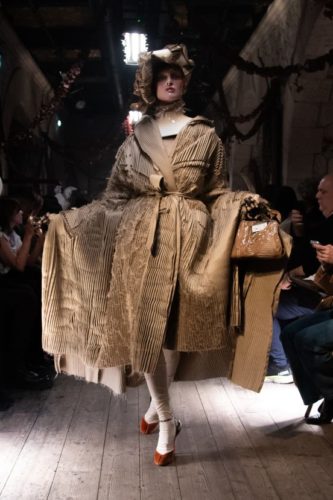
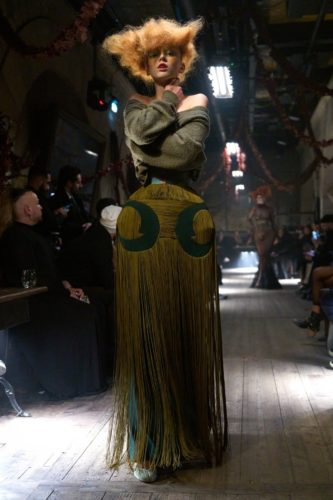
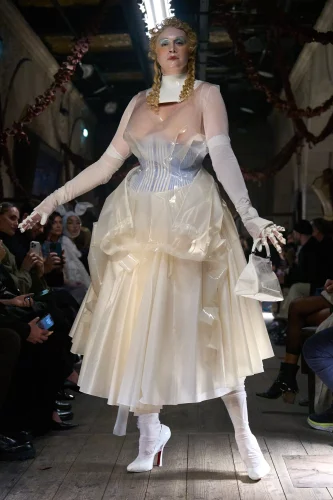


Finally, Margiela. I wasn’t there, so I’m not “reviewing” I’m commenting and observing. Firstly, if ever there was an indication that we want theatrical fashion shows, the response to this show demonstrates the answer clearly. Secondly, it’s exactly ten years since Galliano joined Margiela and he has dipped only his toe in the water previously in seeking to reassert his personal vision, so the moment was right. My only real gripe about the entire thing; why not call it Galliano? The links to any form of Margiela fashion attitude, historical context or clothing philosophy was tenuous to say the least. Everyone who adored the show and from the brilliant/extraordinary/phenomenal – choose your word- Pat McGrath makeup to the casting, the location etc its was wonderful indeed but it was pure John Galliano. The clothes are secondary in some ways because the Margiela commercial label reissues and works around the core of the key Martin Margiela pieces which are timeless and continually desirable. This was an exercise in reestablishing John Galliano as a fashion voice, and with his own vision of down and out, distressed, eccentric and unique it did that very successfully. Now, what’s next for Galliano and Margiela?
What’s my conclusion? Well, I’ve explained the context, my couture views, and responses, to you, and hope that if you’ve not examined some of these designers already it inspires you to think about their work. In the meantime, I’m thinking about the end of June and next season, where will it take us?


